Endocrinology Discussion
VerifiedAdded on 2023/04/21
|11
|1113
|409
AI Summary
This document provides a comprehensive discussion on endocrinology, focusing on the function of the pituitary gland, hormones produced, causes and clinical manifestations of gland hyper-function and hypo-function. It covers topics such as hyperpituitarism, acromegaly, prolactinoma, hyperthyroidism, hypopituitarism, and various disorders caused by pituitary hormone deficiency.
Contribute Materials
Your contribution can guide someone’s learning journey. Share your
documents today.

Running head: ENDOCRINOLOGY DISCUSSION
ENDOCRINOLOGY DISCUSSION
Name of the student:
Name of the university:
Author note:
ENDOCRINOLOGY DISCUSSION
Name of the student:
Name of the university:
Author note:
Secure Best Marks with AI Grader
Need help grading? Try our AI Grader for instant feedback on your assignments.
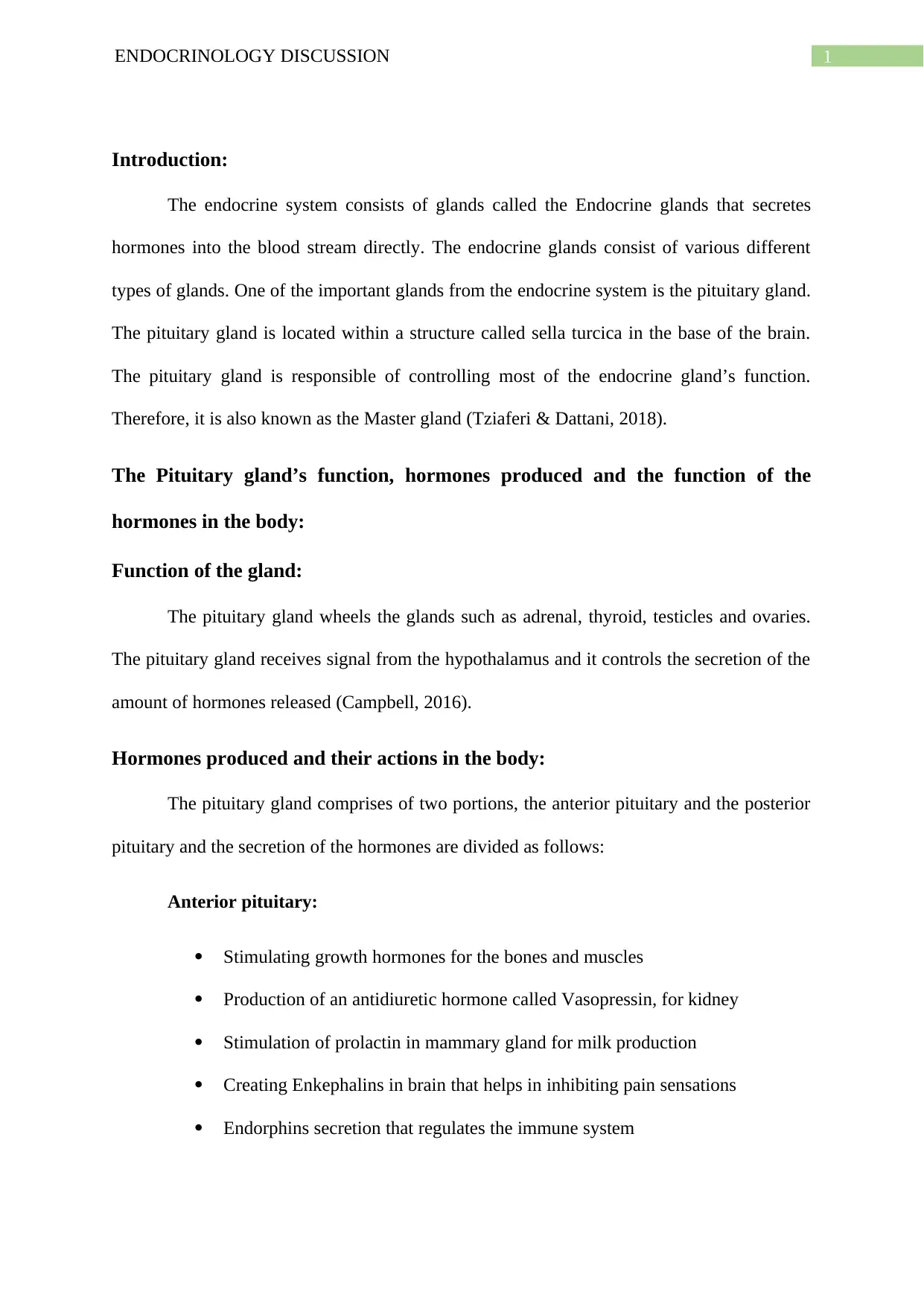
1ENDOCRINOLOGY DISCUSSION
Introduction:
The endocrine system consists of glands called the Endocrine glands that secretes
hormones into the blood stream directly. The endocrine glands consist of various different
types of glands. One of the important glands from the endocrine system is the pituitary gland.
The pituitary gland is located within a structure called sella turcica in the base of the brain.
The pituitary gland is responsible of controlling most of the endocrine gland’s function.
Therefore, it is also known as the Master gland (Tziaferi & Dattani, 2018).
The Pituitary gland’s function, hormones produced and the function of the
hormones in the body:
Function of the gland:
The pituitary gland wheels the glands such as adrenal, thyroid, testicles and ovaries.
The pituitary gland receives signal from the hypothalamus and it controls the secretion of the
amount of hormones released (Campbell, 2016).
Hormones produced and their actions in the body:
The pituitary gland comprises of two portions, the anterior pituitary and the posterior
pituitary and the secretion of the hormones are divided as follows:
Anterior pituitary:
Stimulating growth hormones for the bones and muscles
Production of an antidiuretic hormone called Vasopressin, for kidney
Stimulation of prolactin in mammary gland for milk production
Creating Enkephalins in brain that helps in inhibiting pain sensations
Endorphins secretion that regulates the immune system
Introduction:
The endocrine system consists of glands called the Endocrine glands that secretes
hormones into the blood stream directly. The endocrine glands consist of various different
types of glands. One of the important glands from the endocrine system is the pituitary gland.
The pituitary gland is located within a structure called sella turcica in the base of the brain.
The pituitary gland is responsible of controlling most of the endocrine gland’s function.
Therefore, it is also known as the Master gland (Tziaferi & Dattani, 2018).
The Pituitary gland’s function, hormones produced and the function of the
hormones in the body:
Function of the gland:
The pituitary gland wheels the glands such as adrenal, thyroid, testicles and ovaries.
The pituitary gland receives signal from the hypothalamus and it controls the secretion of the
amount of hormones released (Campbell, 2016).
Hormones produced and their actions in the body:
The pituitary gland comprises of two portions, the anterior pituitary and the posterior
pituitary and the secretion of the hormones are divided as follows:
Anterior pituitary:
Stimulating growth hormones for the bones and muscles
Production of an antidiuretic hormone called Vasopressin, for kidney
Stimulation of prolactin in mammary gland for milk production
Creating Enkephalins in brain that helps in inhibiting pain sensations
Endorphins secretion that regulates the immune system
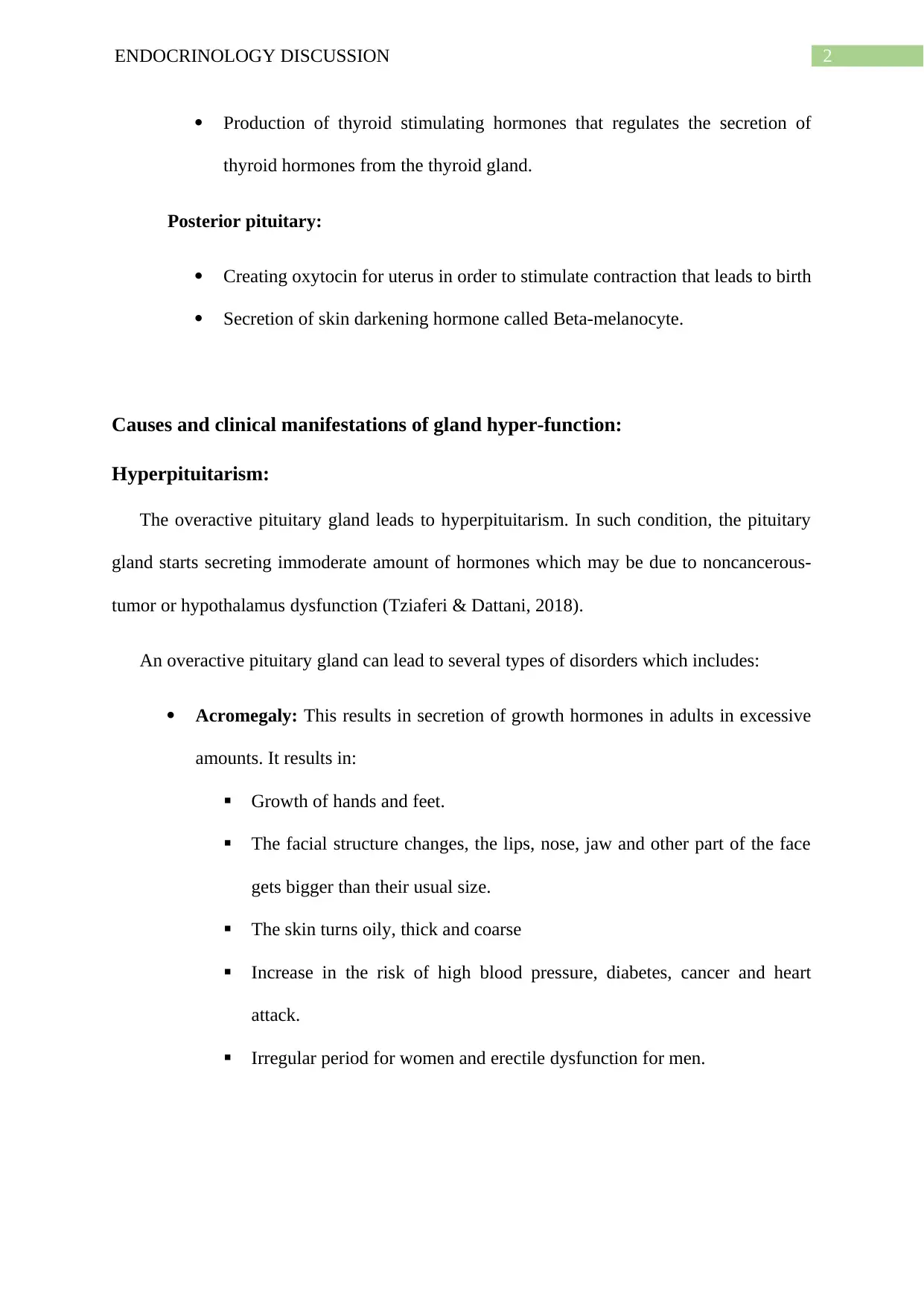
2ENDOCRINOLOGY DISCUSSION
Production of thyroid stimulating hormones that regulates the secretion of
thyroid hormones from the thyroid gland.
Posterior pituitary:
Creating oxytocin for uterus in order to stimulate contraction that leads to birth
Secretion of skin darkening hormone called Beta-melanocyte.
Causes and clinical manifestations of gland hyper-function:
Hyperpituitarism:
The overactive pituitary gland leads to hyperpituitarism. In such condition, the pituitary
gland starts secreting immoderate amount of hormones which may be due to noncancerous-
tumor or hypothalamus dysfunction (Tziaferi & Dattani, 2018).
An overactive pituitary gland can lead to several types of disorders which includes:
Acromegaly: This results in secretion of growth hormones in adults in excessive
amounts. It results in:
Growth of hands and feet.
The facial structure changes, the lips, nose, jaw and other part of the face
gets bigger than their usual size.
The skin turns oily, thick and coarse
Increase in the risk of high blood pressure, diabetes, cancer and heart
attack.
Irregular period for women and erectile dysfunction for men.
Production of thyroid stimulating hormones that regulates the secretion of
thyroid hormones from the thyroid gland.
Posterior pituitary:
Creating oxytocin for uterus in order to stimulate contraction that leads to birth
Secretion of skin darkening hormone called Beta-melanocyte.
Causes and clinical manifestations of gland hyper-function:
Hyperpituitarism:
The overactive pituitary gland leads to hyperpituitarism. In such condition, the pituitary
gland starts secreting immoderate amount of hormones which may be due to noncancerous-
tumor or hypothalamus dysfunction (Tziaferi & Dattani, 2018).
An overactive pituitary gland can lead to several types of disorders which includes:
Acromegaly: This results in secretion of growth hormones in adults in excessive
amounts. It results in:
Growth of hands and feet.
The facial structure changes, the lips, nose, jaw and other part of the face
gets bigger than their usual size.
The skin turns oily, thick and coarse
Increase in the risk of high blood pressure, diabetes, cancer and heart
attack.
Irregular period for women and erectile dysfunction for men.
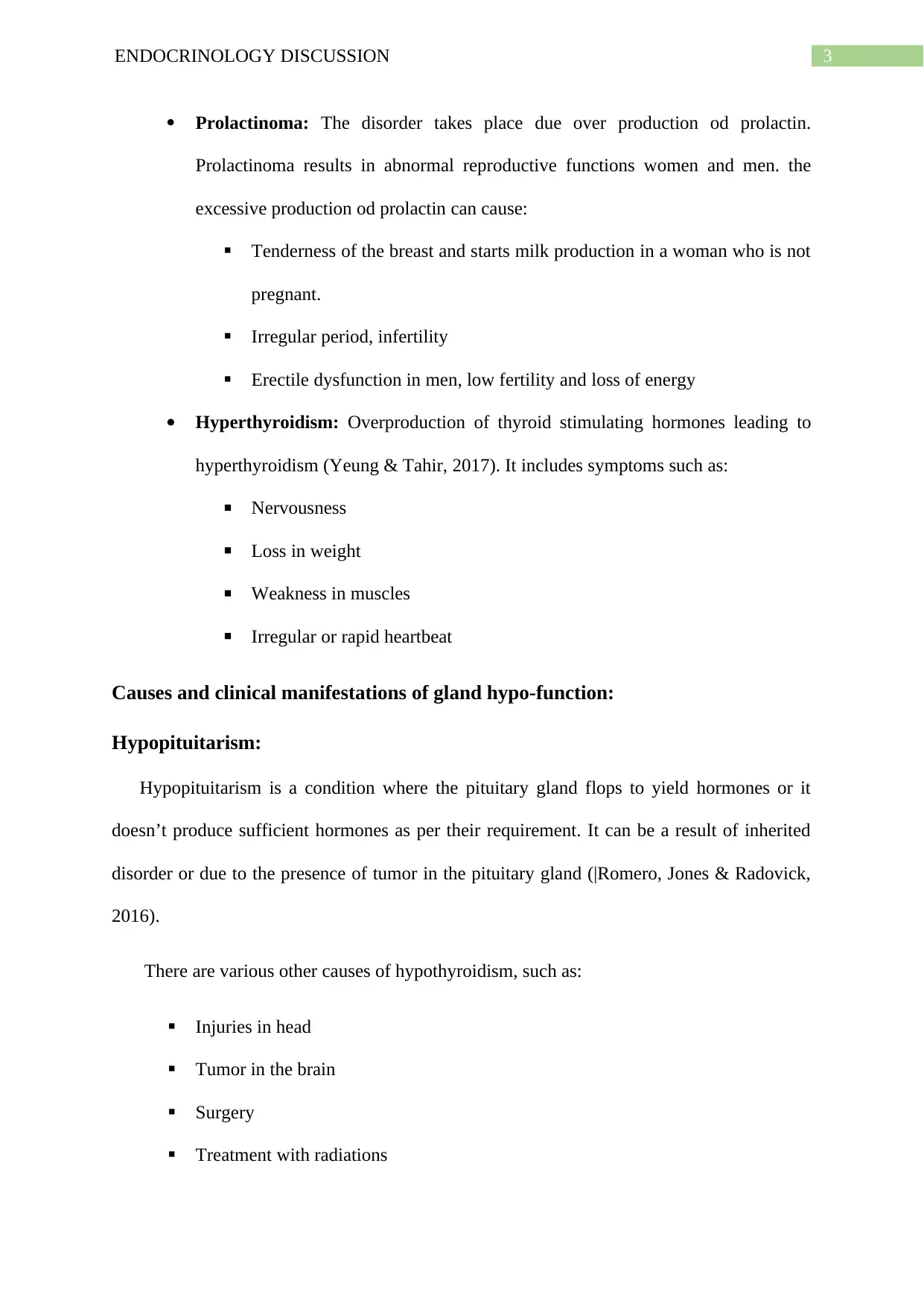
3ENDOCRINOLOGY DISCUSSION
Prolactinoma: The disorder takes place due over production od prolactin.
Prolactinoma results in abnormal reproductive functions women and men. the
excessive production od prolactin can cause:
Tenderness of the breast and starts milk production in a woman who is not
pregnant.
Irregular period, infertility
Erectile dysfunction in men, low fertility and loss of energy
Hyperthyroidism: Overproduction of thyroid stimulating hormones leading to
hyperthyroidism (Yeung & Tahir, 2017). It includes symptoms such as:
Nervousness
Loss in weight
Weakness in muscles
Irregular or rapid heartbeat
Causes and clinical manifestations of gland hypo-function:
Hypopituitarism:
Hypopituitarism is a condition where the pituitary gland flops to yield hormones or it
doesn’t produce sufficient hormones as per their requirement. It can be a result of inherited
disorder or due to the presence of tumor in the pituitary gland (|Romero, Jones & Radovick,
2016).
There are various other causes of hypothyroidism, such as:
Injuries in head
Tumor in the brain
Surgery
Treatment with radiations
Prolactinoma: The disorder takes place due over production od prolactin.
Prolactinoma results in abnormal reproductive functions women and men. the
excessive production od prolactin can cause:
Tenderness of the breast and starts milk production in a woman who is not
pregnant.
Irregular period, infertility
Erectile dysfunction in men, low fertility and loss of energy
Hyperthyroidism: Overproduction of thyroid stimulating hormones leading to
hyperthyroidism (Yeung & Tahir, 2017). It includes symptoms such as:
Nervousness
Loss in weight
Weakness in muscles
Irregular or rapid heartbeat
Causes and clinical manifestations of gland hypo-function:
Hypopituitarism:
Hypopituitarism is a condition where the pituitary gland flops to yield hormones or it
doesn’t produce sufficient hormones as per their requirement. It can be a result of inherited
disorder or due to the presence of tumor in the pituitary gland (|Romero, Jones & Radovick,
2016).
There are various other causes of hypothyroidism, such as:
Injuries in head
Tumor in the brain
Surgery
Treatment with radiations
Secure Best Marks with AI Grader
Need help grading? Try our AI Grader for instant feedback on your assignments.

4ENDOCRINOLOGY DISCUSSION
Inflammation
Stroke
Mutations in the glands
Severe blood loss
Various types of disorders that may cause due to less secretion of pituitary hormones:
Hypothyroidism
Growth hormone deficiency
Adrenocorticotropic hormone deficiency
Prolactin deficiency
Pituitary apoplexy
Symptoms:
Loss of weight
Decrease in sex drive
Difficulty in keeping the body warm
Loss of appetite
Puffiness of face
Anemia
Infertility in both men and women
Irregular or sometimes no periods, pubic hair loss, and inability in milk production
after child birth
Short height in children (Scanes, 2015).
Inflammation
Stroke
Mutations in the glands
Severe blood loss
Various types of disorders that may cause due to less secretion of pituitary hormones:
Hypothyroidism
Growth hormone deficiency
Adrenocorticotropic hormone deficiency
Prolactin deficiency
Pituitary apoplexy
Symptoms:
Loss of weight
Decrease in sex drive
Difficulty in keeping the body warm
Loss of appetite
Puffiness of face
Anemia
Infertility in both men and women
Irregular or sometimes no periods, pubic hair loss, and inability in milk production
after child birth
Short height in children (Scanes, 2015).
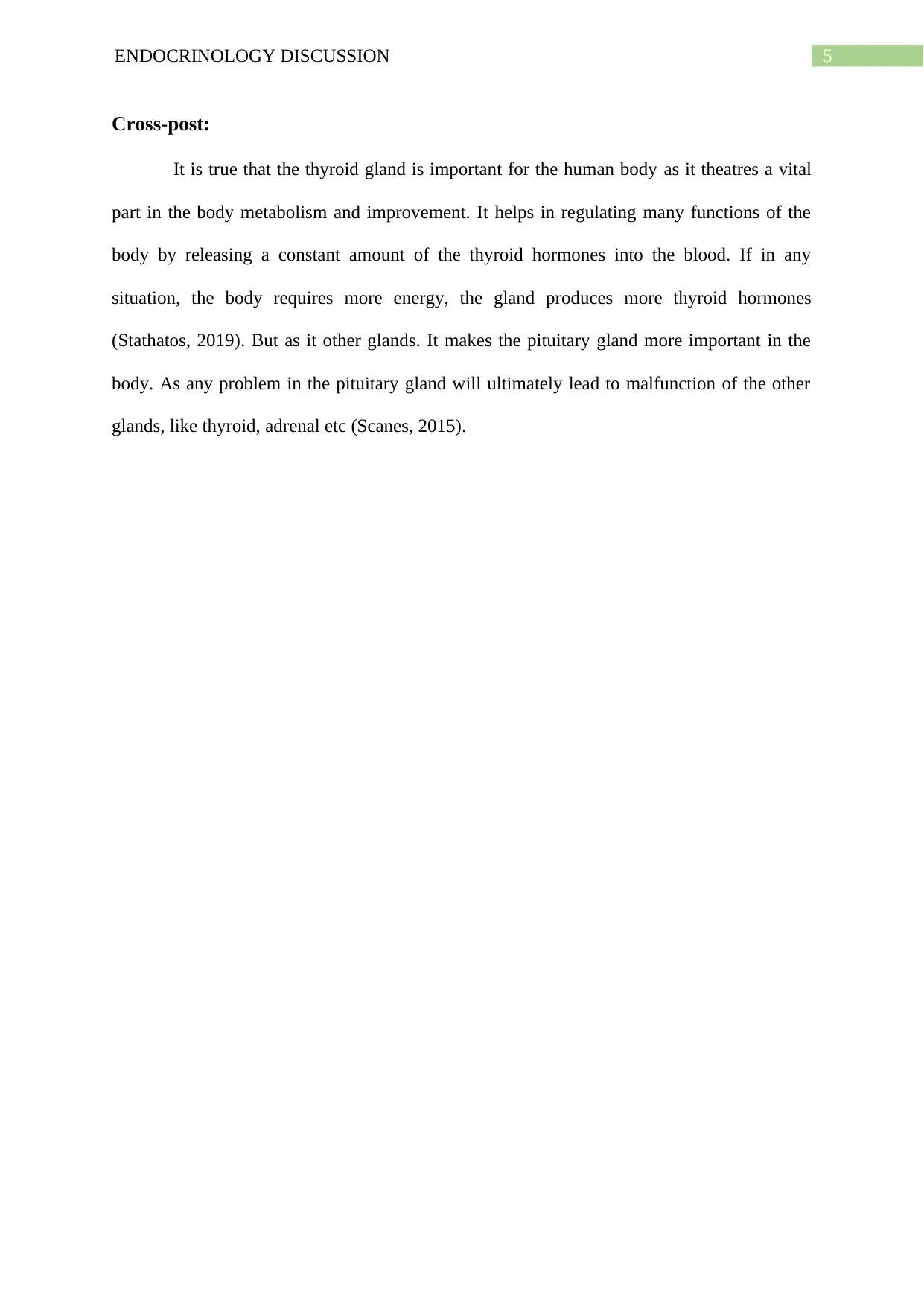
5ENDOCRINOLOGY DISCUSSION
Cross-post:
It is true that the thyroid gland is important for the human body as it theatres a vital
part in the body metabolism and improvement. It helps in regulating many functions of the
body by releasing a constant amount of the thyroid hormones into the blood. If in any
situation, the body requires more energy, the gland produces more thyroid hormones
(Stathatos, 2019). But as it other glands. It makes the pituitary gland more important in the
body. As any problem in the pituitary gland will ultimately lead to malfunction of the other
glands, like thyroid, adrenal etc (Scanes, 2015).
Cross-post:
It is true that the thyroid gland is important for the human body as it theatres a vital
part in the body metabolism and improvement. It helps in regulating many functions of the
body by releasing a constant amount of the thyroid hormones into the blood. If in any
situation, the body requires more energy, the gland produces more thyroid hormones
(Stathatos, 2019). But as it other glands. It makes the pituitary gland more important in the
body. As any problem in the pituitary gland will ultimately lead to malfunction of the other
glands, like thyroid, adrenal etc (Scanes, 2015).
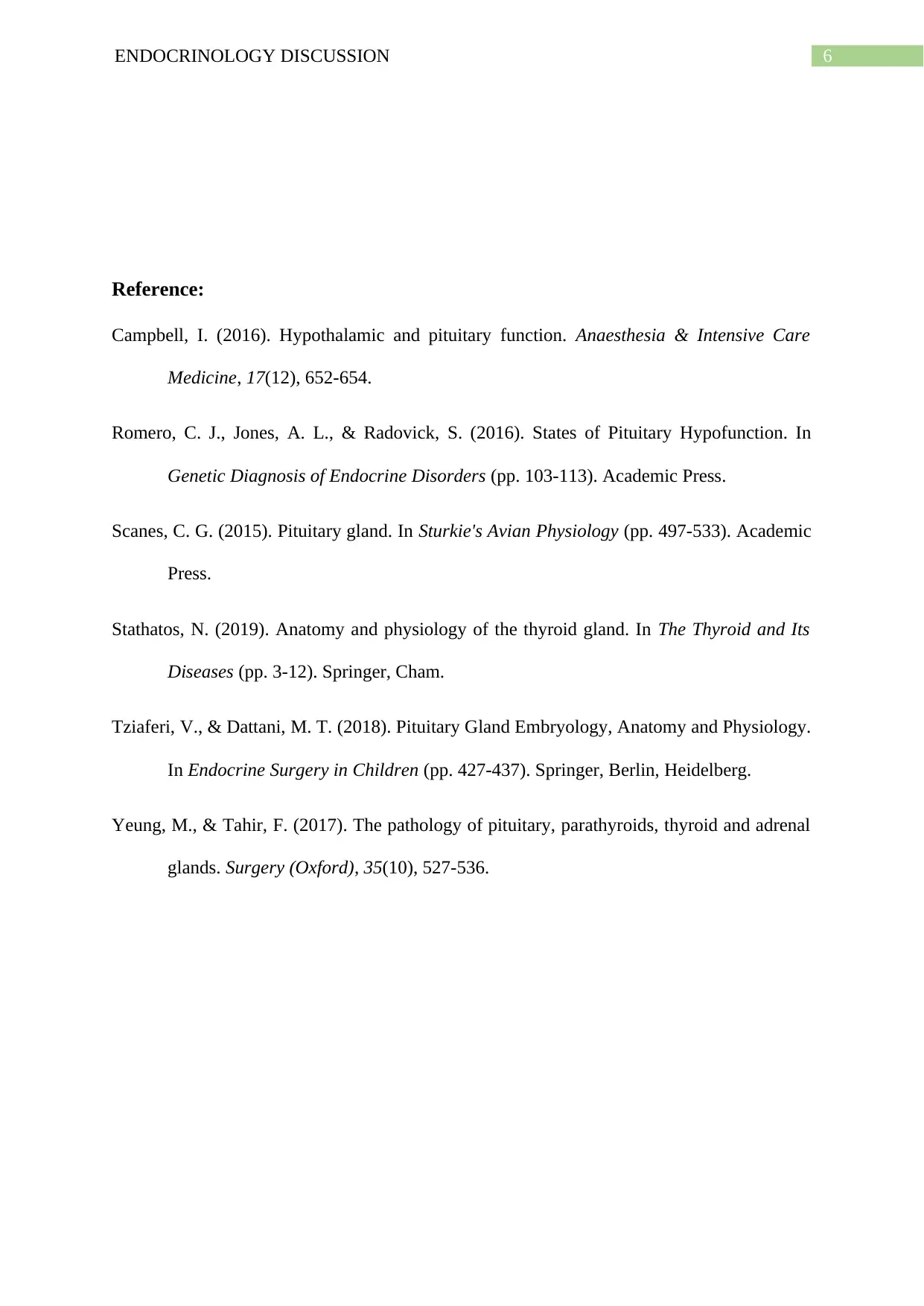
6ENDOCRINOLOGY DISCUSSION
Reference:
Campbell, I. (2016). Hypothalamic and pituitary function. Anaesthesia & Intensive Care
Medicine, 17(12), 652-654.
Romero, C. J., Jones, A. L., & Radovick, S. (2016). States of Pituitary Hypofunction. In
Genetic Diagnosis of Endocrine Disorders (pp. 103-113). Academic Press.
Scanes, C. G. (2015). Pituitary gland. In Sturkie's Avian Physiology (pp. 497-533). Academic
Press.
Stathatos, N. (2019). Anatomy and physiology of the thyroid gland. In The Thyroid and Its
Diseases (pp. 3-12). Springer, Cham.
Tziaferi, V., & Dattani, M. T. (2018). Pituitary Gland Embryology, Anatomy and Physiology.
In Endocrine Surgery in Children (pp. 427-437). Springer, Berlin, Heidelberg.
Yeung, M., & Tahir, F. (2017). The pathology of pituitary, parathyroids, thyroid and adrenal
glands. Surgery (Oxford), 35(10), 527-536.
Reference:
Campbell, I. (2016). Hypothalamic and pituitary function. Anaesthesia & Intensive Care
Medicine, 17(12), 652-654.
Romero, C. J., Jones, A. L., & Radovick, S. (2016). States of Pituitary Hypofunction. In
Genetic Diagnosis of Endocrine Disorders (pp. 103-113). Academic Press.
Scanes, C. G. (2015). Pituitary gland. In Sturkie's Avian Physiology (pp. 497-533). Academic
Press.
Stathatos, N. (2019). Anatomy and physiology of the thyroid gland. In The Thyroid and Its
Diseases (pp. 3-12). Springer, Cham.
Tziaferi, V., & Dattani, M. T. (2018). Pituitary Gland Embryology, Anatomy and Physiology.
In Endocrine Surgery in Children (pp. 427-437). Springer, Berlin, Heidelberg.
Yeung, M., & Tahir, F. (2017). The pathology of pituitary, parathyroids, thyroid and adrenal
glands. Surgery (Oxford), 35(10), 527-536.
Paraphrase This Document
Need a fresh take? Get an instant paraphrase of this document with our AI Paraphraser

7ENDOCRINOLOGY DISCUSSION

8ENDOCRINOLOGY DISCUSSION

9ENDOCRINOLOGY DISCUSSION
Secure Best Marks with AI Grader
Need help grading? Try our AI Grader for instant feedback on your assignments.

10ENDOCRINOLOGY DISCUSSION
1 out of 11
Related Documents
Your All-in-One AI-Powered Toolkit for Academic Success.
+13062052269
info@desklib.com
Available 24*7 on WhatsApp / Email
![[object Object]](/_next/static/media/star-bottom.7253800d.svg)
Unlock your academic potential
© 2024 | Zucol Services PVT LTD | All rights reserved.




